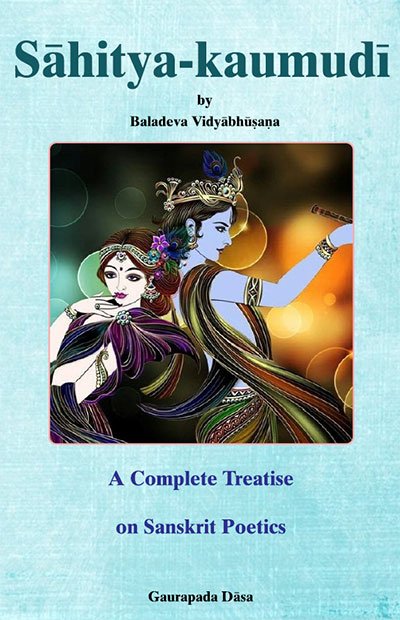Sahitya-kaumudi by Baladeva Vidyabhushana
by Gaurapada Dāsa | 2015 | 234,703 words
Baladeva Vidyabhusana’s Sahitya-kaumudi covers all aspects of poetical theory except the topic of dramaturgy. All the definitions of poetical concepts are taken from Mammata’s Kavya-prakasha, the most authoritative work on Sanskrit poetical rhetoric. Baladeva Vidyabhushana added the eleventh chapter, where he expounds additional ornaments from Visv...
Text 7.118
अपास्याः साधुभिः सार्धम् अजर्घाः किं फलं त्वकम् |
जाहर्हि प्रणतिं तेषां दुर्वृत्तं मङ्क्षु जङ्घहि ||
apāsyāḥ sādhubhiḥ sārdham ajarghāḥ kiṃ phalaṃ tvakam |
jāharhi praṇatiṃ teṣāṃ durvṛttaṃ maṅkṣu jaṅghahi ||
apāsyāḥ—you discarded (argued) (yaṅ-anta of apa + as[u] kṣepaṇe)[1]; sādhubhiḥ sārdham—with saintly persons; ajarghāḥ—intensely desired (carkarīta of gṛdh[u] abhikāṅkṣāyām)[2]; kim—what?; phalam—result; tvakam—despicable you[3]; jāharhi—intensely desire (or repeatedly desire) (carkarīta of hary gati-kāntyoḥ)[4]; praṇatim—salutation; teṣām—their; durvṛttam—bad state of mind; maṅkṣu—quickly; jaṅghahi—intensely kill (carkarīta of han hiṃsā-gatyoḥ).[5]
You repeatedly argued with sādhus. What result did despicable you want to achieve? Intensely seek their salutations. Forcefully and quickly kill your bad attitude.
atra vaiyākaraṇo vaktā. evam asya boddhavyatve’pi bodhyam.
Here the speaker is a grammarian. Other such examples are to be understood even when a grammarian is the person who is addressed.
Commentary:
Some grammatical forms above are very rare. They are literary qualities in this context. In other instances, each one of those would be categorized as the fault called kaṣṭa (difficult to understand).
Footnotes and references:
[1]:
The author of Kṛṣṇānandinī glosses apāsyāḥ as: punaḥ punaḥ spardhām akaroḥ (you repeatedly engaged in rivalry).
[2]:
The author of Kṛṣṇānandinī explains ajarghāḥ as bhṛśam abhyakāṅkṣaḥ (you intensely desired). However, the form should be ajargāḥ. The explanation is as follows: As a carkarīta, after the affix r (Aṣṭādhyāyī 7.4.91-92) and the simple past prefix a[t] are added to the verbal root gṛdh[u], the result is ajargṛdh. Then, dh optionally changes to r by the rule: daś ca (Aṣṭādhyāyī 7.2.109). Afterward, the 2.1 simple past suffix s[ip] is added, guṇa is done, and the result is ajargarr, since s[ip] gets deleted after a consonant.Then the form becomes ajargār because the second-to-last r gets deleted (ro ri, Aṣṭādhyāyī 8.3.14) and the short vowel before it becomes long (ḍhra-lope pūrvasya dīrgho’ṇaḥ, Aṣṭādhyāyī 6.3.111). The r at the end changes to a visarga (Aṣṭādhyāyī 8.3.15): The final form is ajargāḥ.
[3]:
The affix ak[ac] is inserted in tvam to make tvakam, and here the sense is kutsita (contempt) (Aṣṭādhyāyī 5.3.71) (HNV 1262).
[4]:
[5]:
jaṅghahi bhṛśaṃ jahi tyajety arthaḥ (Kṛṣṇānandinī).
